Content
- 1 Is it possible to grow grapes from seeds?
- 2 Will grapes grown from seed bear fruit?
- 3 Variety selection
- 4 Growing grapes from seed at home
- 5 How grapes sprout from seed
- 6 Features of care
- 7 How to speed up the growth of grapes
- 8 Transplanting seedlings into open ground
- 9 Caring for grapes after transplantation
- 10 Tips and tricks
- 11 Conclusion
It is quite possible to grow fruit-bearing grapes from seeds - the crop can be propagated not only by cuttings and layering. But before propagating the plant, you need to learn important planting and care rules.
Is it possible to grow grapes from seeds?
Seed grapes can be grown at home for subsequent replanting in the ground. The only condition is to use varieties with large, healthy seeds. In some varieties of culture there are simply no suitable seeds, for example, sultanas reproduce only vegetatively.
Common varieties respond well to growing from seed. The gardener is only required to follow the basic rules when planting and caring.
Will grapes grown from seed bear fruit?
Grapes from seeds will bear fruit just as well as a plant obtained vegetatively. The only difference is that seed bushes will produce berries for the first time only after 4-5 years.
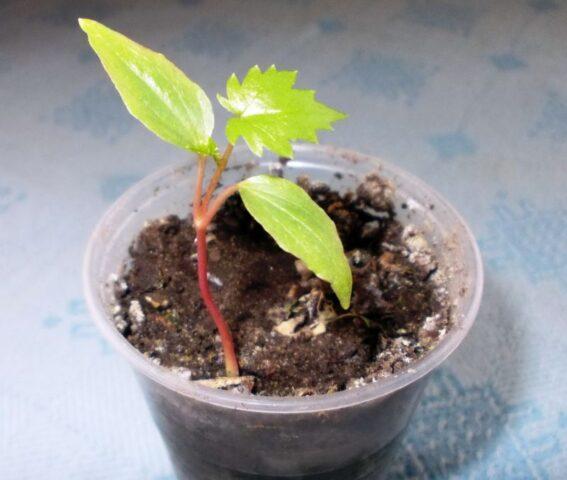
The disadvantage of seed propagation of grapes is that the seedlings often do not retain varietal characteristics
Variety selection
To choose the right variety for growing from seed, you need to consider several points:
- Terms of ripening. In the southern regions, almost any variety can be successfully grown and transplanted into the soil. For the middle zone, it is better to choose early and mid-ripening grapes - they will have time to ripen in open ground even in a sunny and cool summer.
- Productivity. When choosing a variety, you need to pay attention to the mass of brushes. The best yield indicators are demonstrated by species with clusters of 500-900 g.
- Immunity to diseases. If you grow grapes from a seed, then in a pot they are unlikely to suffer from fungi and pests, but they may get sick after being transferred to the ground. It is better to give preference to the hardiest varieties.
When choosing a variety, frost resistance must also be taken into account. In the middle zone, grapes must tolerate temperatures down to -25 ° C, otherwise, after transplanting into the ground, they may die in the first winter.
Growing grapes from seed at home
In order for grapes from seed to germinate quickly and not die during development, it is necessary to devote time to preparing the soil and processing planting material. It is important to choose quality seeds from the very beginning and provide good conditions for the crop.
Seed selection and stratification
Before planting grape seeds at home, you need to check the quality of the material:
- carefully examine - a viable seed should have a white liquid visible under the shell;
- check for density - good bones are firm to the touch, without softness, but also without excessive dryness;
- place in lukewarm water - healthy seeds will sink to the bottom, and immature ones will remain floating on the surface.
After checking, the seeds must be washed, filled with fresh liquid and left for a day. Then the seeds are placed in a bag on a layer of peat moss, sprinkled with damp sand on top and put in a cool place for three months. From time to time, the planting material needs to be checked and sprayed with a spray bottle, preventing it from drying out.
Soil preparation
Seeds are planted in the ground in early March. It is possible to grow high-quality seedlings from seeds only in fertile soil. You can actually make it with your own hands - to do this you need to mix humus, soil and sand in equal proportions.
Before planting seeds, it is recommended to spill the soil with a weak solution of potassium permanganate or calcine it in the oven. This will eliminate possible pests and fungal spores.
How to plant grape seeds at home
To grow grapes from grape seeds, planting must be done correctly. The procedure is performed according to the following scheme:
- The seeds are removed from the refrigerator after stratification, washed and inspected to ensure there is no mold.
- The gauze folded in several layers is moistened, the seeds are placed on it and covered with a bag on top.
- For three days, put the seeds in a warm place so that the shell cracks slightly.
- Place a small layer of expanded clay in disposable cups and pour prepared nutrient soil on top.
- Make holes up to 1.5 cm deep in the center of the containers, lay the seeds and sprinkle with soil.
After planting the seeds, it is necessary to cover the cups with polyethylene. This will allow grape seeds to germinate in conditions close to greenhouse conditions.
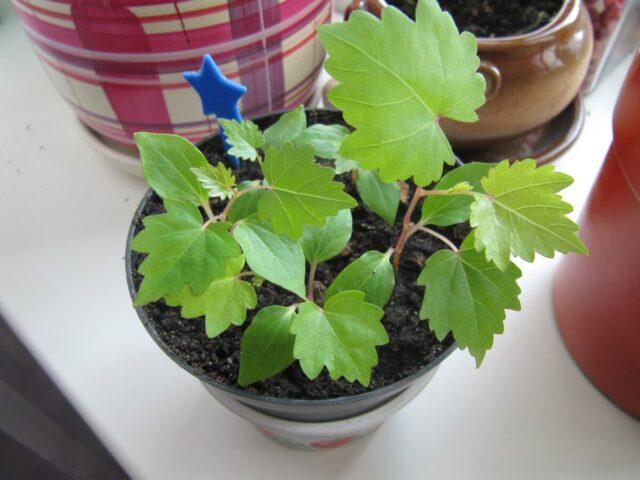
You can grow grapes from seed at a temperature of at least 20 ° C during the day
How grapes sprout from seed
When placed on a well-lit, warm windowsill and subject to temperature conditions, grapes from seed will germinate in 2-8 weeks. During the process, it is necessary to regularly remove the film from the pot to ventilate the soil and spray the soil with a spray bottle as it dries.
You can grow a seedling from a grape seed in stable conditions without sudden cold spells and drafts. Fluctuations between night and day temperatures should not exceed 5 °C.
Features of care
After the shoots have formed, the film is removed from the grapes and they continue to take care of them at home. To grow strong seedlings, you need to pay attention to all the basic aspects of care.
Watering and loosening
The soil in pots with grape sprouts should not dry out, but waterlogging should not be allowed. It is necessary to moisten the soil daily with a spray bottle and lightly loosen it to prevent the formation of an earthen crust and lumps.
Top dressing
You can grow healthy grapes in a pot if you fertilize them regularly. It is necessary to add complex minerals containing nitrogen and phosphorus to the water for irrigation every ten days. Such fertilizers will contribute to the growth of green mass and strengthen the root system.
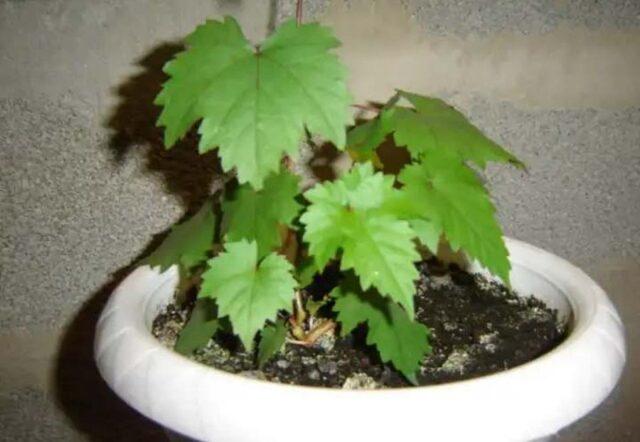
Fertilizing containing copper, zinc and potassium helps to successfully grow grapes from seed.
Disease Control
Pests interfere with growing grapes in a pot. Most often, seedlings are damaged by spider mites - you can recognize them by the characteristic cobwebs on the shoots. If left untreated, the insect can completely destroy the plant.
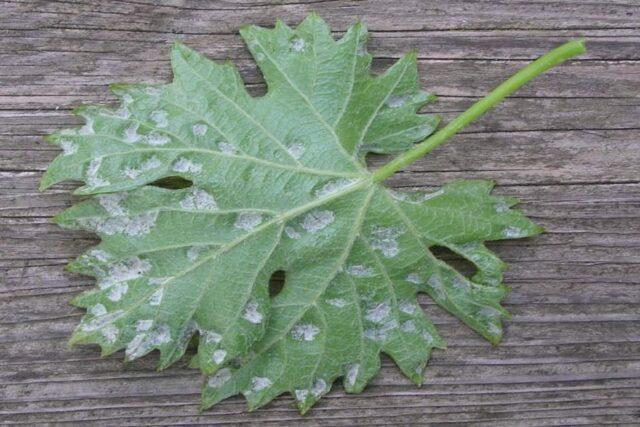
Spider mites settle on the undersides of grape leaves
Spraying with an infusion of wood ash helps get rid of ticks. About 100 g of powder is diluted in 5 liters of water and kept for two days, and then the grapes are processed.
Fungal infections in a closed container usually do not affect the plant, especially if the soil is previously disinfected with a solution of potassium permanganate. But grapes can suffer from root rot if overwatered. In this case, the leaves of the seedlings turn pale and wither, and the stem becomes soft and lies down.
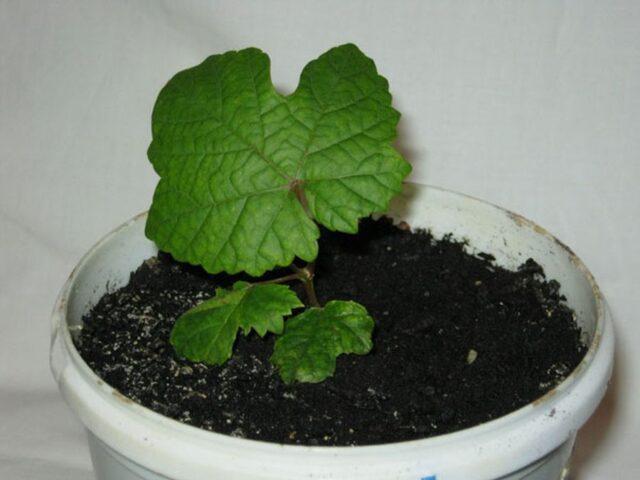
Overmoistening prevents grapes from growing, especially often with “top” watering over the edge of the pot.
To prevent the problem and grow healthy grapes, it is necessary to control the condition of the soil not only on the surface, but also in depth. The easiest way is to plant the seeds in transparent cups, which allow you to assess soil moisture. You can also carefully dig up the soil 1.5-2 cm before each watering and check its condition. If the soil remains moist in the depths of the container, then the grapes do not need to add water again.
Hardening
You can grow grapes from seed in an apartment at a stable temperature and humidity, but after transferring them to the ground, the conditions for the seedlings will change dramatically. To prevent replanting from becoming detrimental to the plants, it is necessary to pre-harden them.
At the end of May, pots of grapes begin to be briefly taken out onto the balcony or open veranda. First, the containers are left outside for a couple of hours, and the hardening duration is gradually increased. In total, adaptation should take about a week; at the end, the seedlings are taken out into the fresh air for a full day.
How to speed up the growth of grapes
Within a few spring months, grapes often do not have time to become sufficiently strong at home. To grow it faster, you can use nitrogenous fertilizers - bird droppings, urea or ammonium nitrate. This feeding activates the development of green stems and leaves, and as a result, by the beginning of summer, the seedlings will be strong enough to be transferred to the garden.
Transplanting seedlings into open ground
After germinating grapes from seeds at home, the strengthened seedlings are transferred to the ground. First of all, you need to choose the right place for the culture. You can grow grapes in a well-lit area with shelter from strong winds. The soil acidity level should be 5.5-7 pH.
The algorithm for planting seedlings is as follows:
- The area is dug up and, if necessary, the soil is acidified or alkalized.
- For grapes, holes are prepared that are twice the size of the root system in depth and diameter.
- A drainage layer is laid at the bottom of the holes and half filled with garden soil mixed with humus in equal proportions.
- Water the soil in advance with warm, settled water.
- Remove the grape seedlings from the containers, carefully straighten the roots and place the plants in the holes.
- Fill the holes to the brim with dry soil.
Transshipment of seedlings into the ground while preserving the earthen clod helps to grow grapes without unnecessary problems.In this case, the roots are not injured, and the bushes take root in the new place as quickly as possible. Wooden pegs are immediately installed next to the plants and the shoots are tied up so that they do not fall to the ground.
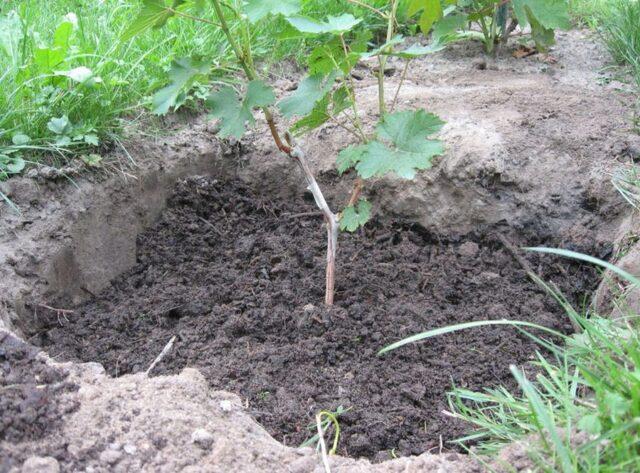
It is necessary to plant grape seedlings from seeds at a distance of 2.5 m from each other
Caring for grapes after transplantation
Following the rules of care allows you to successfully grow a vine from a grape seed. After transferring the bushes to the ground, you must:
- water the plants as the soil dries, while avoiding waterlogging;
- feed the grapes with organic matter or complex minerals from the second year after planting once a month;
- mulch the soil in the tree trunk circle with hay, fallen leaves or river sand to slow down the evaporation of moisture;
- loosen the soil from time to time - this improves oxygen access to the roots and prevents the appearance of fungi and pests;
- annually remove weak and dry shoots or excess lateral branches that thicken the bush.
In the first three years after planting, it is necessary to pick off the grape inflorescences immediately after they form. You must first grow a healthy bush, and only after that take care of the harvest. The flower stalks can be left to develop only in the fourth year, when the seedlings are sufficiently strong.
With the onset of autumn, the area with grapes must be thoroughly cleaned of plant debris. For the winter, the vines of the bush are collected in a bunch and laid on a bed of straw.Then the grapes are sprinkled on top with fallen leaves or dry grass in a layer of 20-40 cm and covered with a net so that the insulating material does not fly apart.
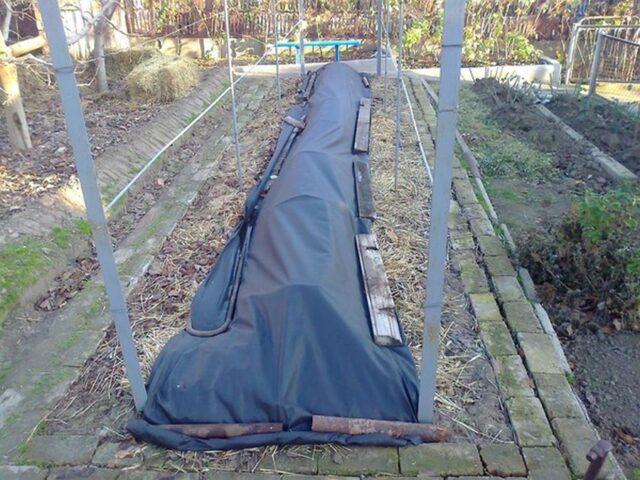
In cold winter conditions, you can build a shelter for grapes from roofing felt or agrofibre
Tips and tricks
To grow a grape tree from a seed at home in a pot and safely transfer it to the ground, you need to follow several recommendations:
- Drainage holes must be made in a closed culture container. Without them, moisture will not leave the pot, and the roots of the grapes will begin to rot.
- When transferring tall varieties to the garden, trellises are immediately installed for seedlings. As the grapes develop, the vines are placed on supports so that they do not intertwine and receive sufficient sunlight.
- Twice a month the bush is sprayed with a solution of wood ash, prepared at the rate of 45 g of powder per 1 liter of water. The product will serve as additional feeding and strengthen the plant’s immunity.
It is not necessary to replant grapes from seed to open ground in the first year. At home, the shrub can be grown to a height of 2 m and only then transferred to the garden.
Conclusion
You can grow fruit-bearing grapes from seeds in a small pot or disposable cup. But after the seedling has become strong enough, it will still need to be transferred to the ground so that it can develop further and produce abundant harvests.








